Must Try Moroccan Dishes
Morocco’s cuisine stands as a vibrant tapestry woven from Berber, Arab, and Mediterranean influences, creating one of the world’s most distinctive culinary traditions. As you wander through the labyrinthine medinas of Marrakech or the coastal markets of Essaouira, the aromas of simmering tagines, freshly baked bread, and exotic spices create an irresistible invitation to explore. This guide unveils must try Moroccan dishes that showcase the country’s remarkable flavors, cooking techniques, and cultural heritage – essential knowledge for any food lover planning to experience this North African culinary paradise.
The Rich Heritage of Moroccan Cuisine
Traditional Moroccan spice market showcasing the essential ingredients for authentic Moroccan flavors
Moroccan cuisine has evolved over centuries, influenced by the country’s position at the crossroads of Africa, Europe, and the Middle East. The Berbers contributed hearty grains and vegetables, while Arab influences brought exotic spices and sweet-savory combinations. Later, Andalusian refugees added sophistication, and Ottoman influences introduced new cooking techniques.
What makes traditional Moroccan dishes truly special is their reliance on slow cooking methods that allow complex flavors to develop fully. Many iconic recipes require hours of gentle simmering in clay pots, creating tender meats and vegetables infused with aromatic spices like cumin, cinnamon, saffron, and ginger.
Throughout Morocco, food remains deeply connected to hospitality and community. Meals are typically shared from communal plates, with bread serving as both utensil and staple. Whether you’re enjoying street food in Fez or a family feast in a mountain village, the experience of Moroccan dining extends far beyond mere sustenance – it’s a celebration of culture, history, and connection.
Iconic Must Try Moroccan Dishes
1.Tagine
Named after the distinctive conical clay pot in which it’s cooked, tagine is perhaps the most famous of all must-try Moroccan dishes. This slow-cooked stew typically features tender meat (lamb, chicken, or beef) combined with vegetables, dried fruits, and a complex blend of spices. The unique design of the tagine pot allows steam to rise, condense, and drip back down, creating incredibly tender meat and vegetables.
Regional Variations: In Marrakech, you’ll find tagines with preserved lemons and olives, while Fez specializes in sweeter versions with prunes and almonds. Coastal regions often prepare fish tagines with chermoula, a zesty herb marinade.
Where to Try It: i recommed this three days from fes to marrakech
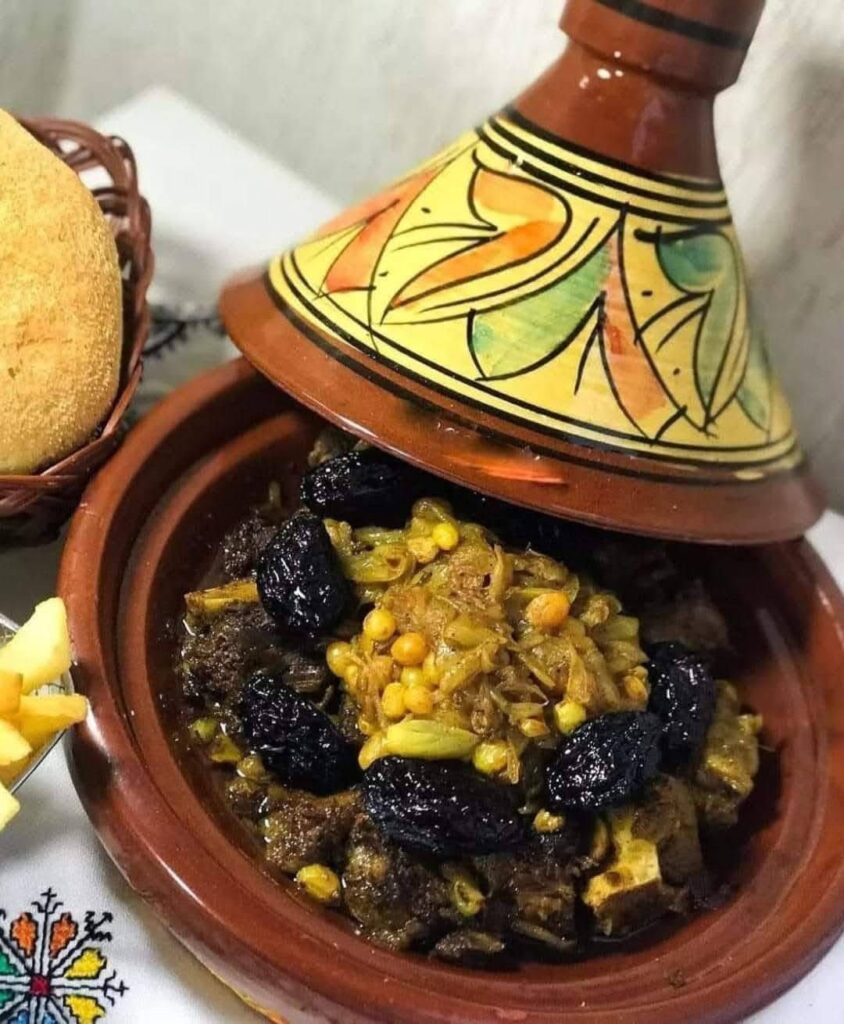
2. Couscous
Considered Morocco’s national dish, couscous is traditionally served on Fridays when families gather after prayers. These tiny steamed semolina granules form a bed for tender vegetables and meat, all flavored with aromatic broth. The preparation is labor-intensive, involving multiple steamings to achieve the perfect light, fluffy texture.
Cultural Significance: Beyond its delicious taste, couscous represents Moroccan hospitality and community. Sharing from a communal plate symbolizes unity and generosity, core values in Moroccan culture.
Where to Try It: For the most authentic experience, try to secure an invitation to a local home on Friday. Alternatively, restaurants excellent versions that honor traditional preparation methods.
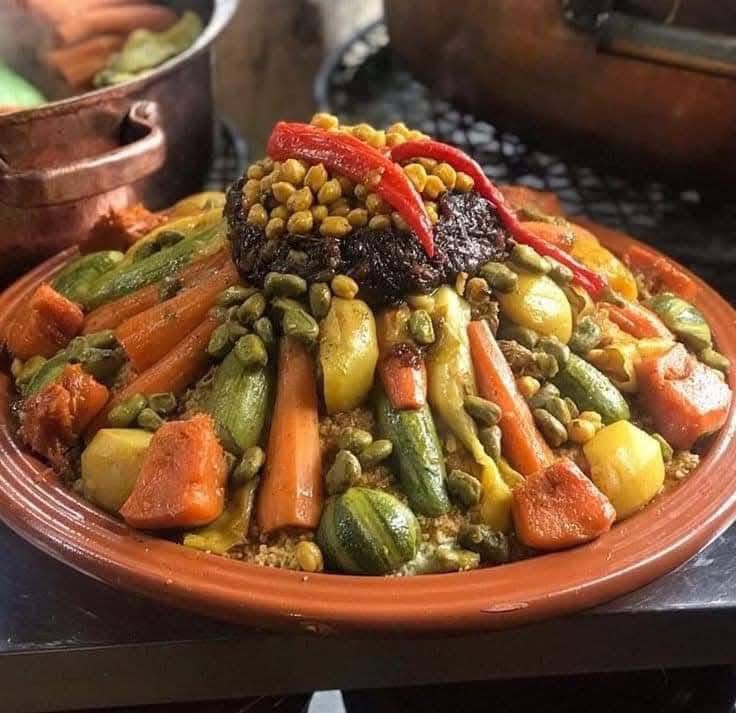
3. Pastilla
Pastilla represents the epitome of Moroccan cuisine’s sweet-savory balance. This elaborate pie features layers of paper-thin pastry (warqa) encasing a filling of shredded poultry (traditionally pigeon, now often chicken), almonds, eggs, and spices. The crowning touch is a dusting of powdered sugar and cinnamon, creating an unexpected yet harmonious flavor contrast.
Historical Context: Pastilla originated in Andalusia and was brought to Morocco by Muslims and Jews fleeing Spain in the 15th century. It remains a celebratory dish served at weddings and special occasions.
Where to Try It: Fez is renowned for the best pastilla. Try Dar Hatim for an authentic version made with traditional techniques and high-quality ingredients.
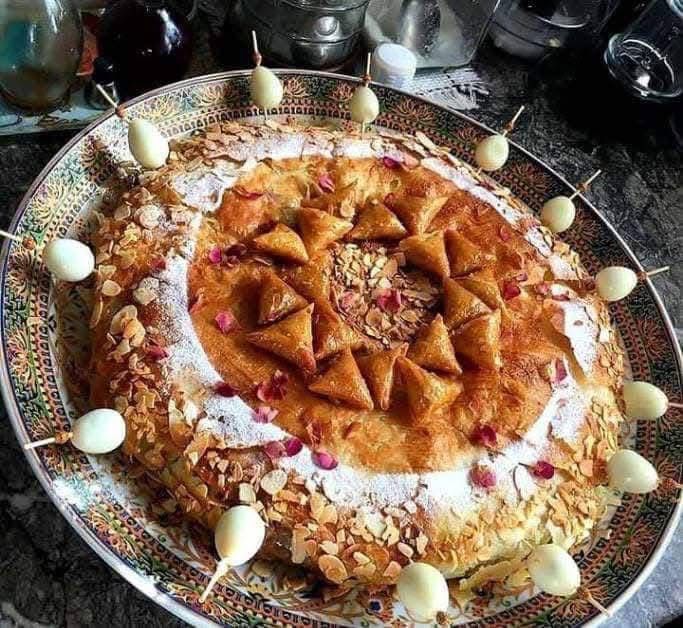
4. Khobz (Bread)
This round, flattish bread is the foundation of Moroccan dining, present at virtually every meal. Khobz features a slightly chewy texture with a crusty exterior, perfect for scooping up tagine sauce or dipping into olive oil. Traditional versions are baked in communal wood-fired ovens that have served neighborhoods for generations.
Cultural Importance: Bread holds sacred status in Moroccan culture – it’s never thrown away, and if a piece falls on the ground, it’s picked up, kissed, and placed aside for animals. Many neighborhoods still maintain communal ovens where families bring their dough to be baked.
Where to Try It: Fresh khobz is available at bakeries throughout Morocco. For an authentic experience, visit a communal oven (ferran) early in the morning to see the baking process and purchase bread directly from the source.
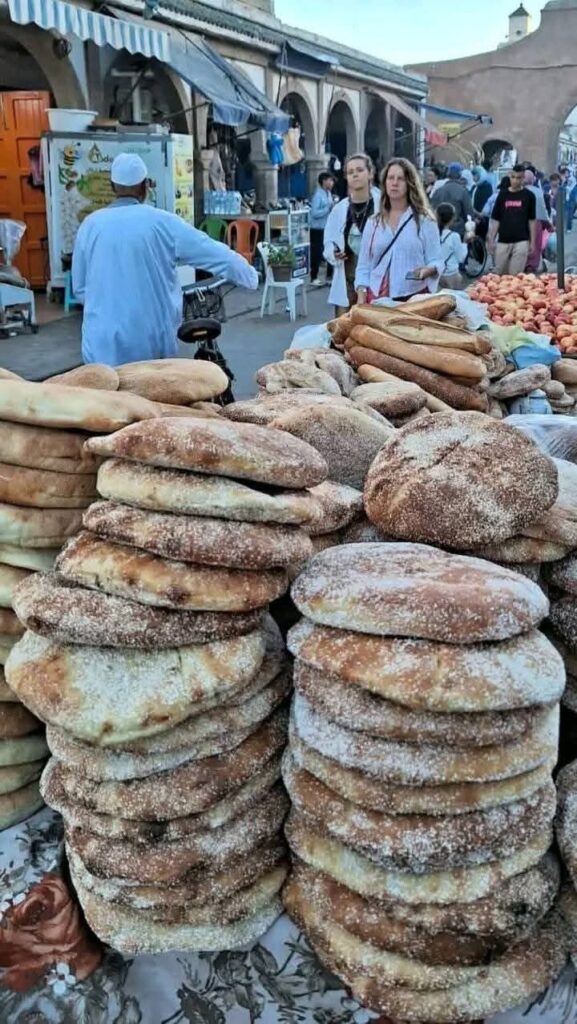
5. Msemen (Crepes)
These square-shaped, flaky pancakes are a popular breakfast and snack food throughout Morocco. Made from folded dough that creates multiple layers, msemen can be enjoyed plain, stuffed with savory fillings, or drizzled with honey for a sweet treat. The preparation is fascinating to watch as skilled hands quickly flatten, fold, and shape the dough.
Versatility: Msemen showcases the versatility of Moroccan bread culture – the same basic dough can become breakfast, lunch, or dessert depending on how it’s served.
Where to Try It: Street vendors specializing in bread products offer the freshest msemen. Look for stalls where you can watch them being made to order, particularly in morning markets.
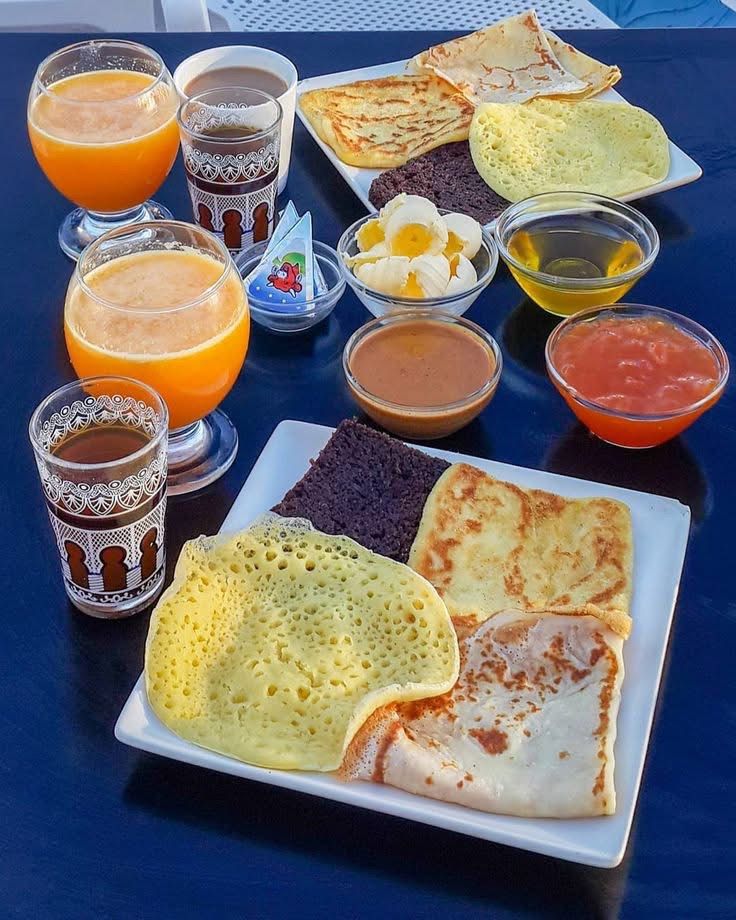
6.Mint Tea
Often called “Moroccan whiskey” in jest, mint tea is the cornerstone of Moroccan hospitality. This sweet green tea infused with fresh mint leaves is served throughout the day, from breakfast to bedtime. The ceremonial preparation – washing the tea, steeping it with mint and sugar, and pouring from a height to create froth – is as important as the drink itself.
Hospitality Symbol: Being offered tea in Morocco is a sign of welcome and friendship. Refusing it can be considered impolite, though you can request “sans sucre” (without sugar) if you prefer a less sweet version.
Where to Try It: Virtually anywhere in Morocco serves mint tea, but for a special experience, try the tea service at La Mamounia hotel in Marrakech or at a traditional tea house in the medina.
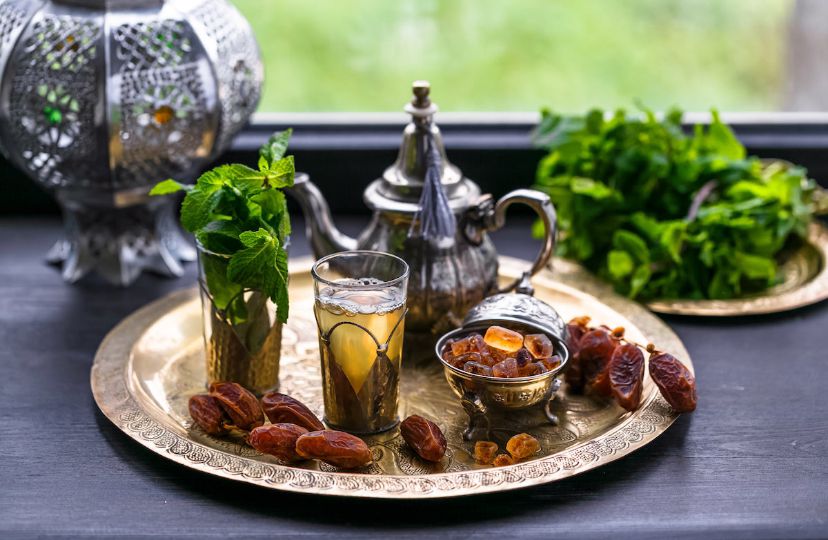
Experience Moroccan Cuisine Firsthand
Reading about these delicious dishes is just the beginning. Imagine learning to prepare authentic tagine, pastilla, or mint tea from expert Moroccan chefs! A cooking class offers the perfect opportunity to take these flavors home with you – a souvenir that lasts far longer than any market purchase.
Find a Moroccan Cooking Class
Learn to prepare authentic Moroccan dishes in a traditional cooking class
Is Moroccan food spicy?
Contrary to common assumptions, most traditional Moroccan dishes are not spicy-hot. Moroccan cuisine emphasizes aromatic rather than hot spices, using ingredients like cinnamon, cumin, turmeric, and ginger to create depth of flavor without intense heat. That said, you’ll often find harissa (chili paste) served on the side, allowing diners to add heat according to their preference.
What vegetarian options exist in Moroccan cuisine?
Vegetarians can enjoy many traditional Moroccan dishes, including vegetable tagines, zaalouk (eggplant salad), taktouka (pepper salad), vegetable couscous, harira soup (request without meat), and a variety of bean dishes. In tourist areas, restaurants are increasingly accommodating to vegetarian diets. When ordering, simply specify “bidoun lahm” (without meat) to ensure your meal meets your requirements.
How do I eat like a local in Morocco?
To eat like a Moroccan:
Use your right hand for eating, never the left
Tear bread into small pieces and use it to scoop food
Eat from the portion of communal dishes directly in front of you
Accept mint tea when offered – it’s a gesture of hospitality
Try local street food where you see crowds of Moroccans
Embrace the leisurely pace of meals – dining is a social experience, not just about nutrition
When is the best time to visit Morocco for food experiences?
While Moroccan cuisine can be enjoyed year-round, certain times offer unique culinary experiences. Ramadan provides insight into special festive foods like harira and chebakia, though be aware that daytime dining options may be limited. Autumn brings harvest festivals with fresh produce, while winter is peak season for citrus fruits and the famous Moroccan oranges. Spring offers pleasant weather for food market exploration without extreme heat.
Bringing Morocco's Flavors Home
Morocco’s cuisine offers a sensory journey through centuries of cultural exchange, refined techniques, and cherished traditions. From the steam rising from a freshly opened tagine to the theatrical pouring of mint tea, these must-try Moroccan dishes provide more than sustenance – they offer insight into the soul of this fascinating country.
As you plan your Moroccan adventure, make food exploration a priority. Seek out local markets, accept invitations to family meals when possible, and don’t hesitate to ask locals for their favorite spots. The most memorable meals often happen in the most unexpected places, away from tourist paths.
And remember – the flavors of Morocco can travel home with you. Consider purchasing spice blends like ras el hanout, preserved lemons, or argan oil to recreate these dishes in your own kitchen. Better yet, book a cooking class during your stay to learn authentic techniques firsthand. Your culinary souvenirs will continue to evoke memories of Morocco long after your journey ends.
Ready to Taste Must Try Moroccan Dishes ?
Start planning your culinary adventure through Morocco’s medinas, markets, and restaurants. From street food to royal feasts, unforgettable flavors await to try Must Try Moroccan Dishes.
Explore moroccan food tour
